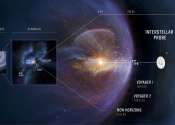Mapping the best route for a spacecraft traveling beyond the sun's sphere of influence
The heliosphere—made of solar wind, solar transients, and the interplanetary magnetic field—acts as our solar system's personal shield, protecting the planets from galactic cosmic rays. These extremely energetic particles ...









